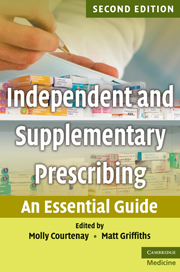Book contents
- Frontmatter
- Contents
- List of contributors
- Foreword to the second edition
- Preface to the second edition
- 1 Non-medical prescribing: an overview
- 2 Non-medical prescribing in a multidisciplinary team context
- 3 Consultation skills and decision making
- 4 Legal aspects of independent and supplementary prescribing
- 5 Ethical issues in independent and supplementary prescribing
- 6 Psychology and sociology of prescribing
- 7 Applied pharmacology
- 8 Monitoring skills
- 9 Promoting concordance in prescribing interactions
- 10 Evidence-based prescribing
- 11 Extended/supplementary prescribing: a public health perspective
- 12 Calculation skills
- 13 Prescribing in practice: how it works
- 14 Minimising the risk of prescribing error
- Index
- References
8 - Monitoring skills
Published online by Cambridge University Press: 10 January 2011
- Frontmatter
- Contents
- List of contributors
- Foreword to the second edition
- Preface to the second edition
- 1 Non-medical prescribing: an overview
- 2 Non-medical prescribing in a multidisciplinary team context
- 3 Consultation skills and decision making
- 4 Legal aspects of independent and supplementary prescribing
- 5 Ethical issues in independent and supplementary prescribing
- 6 Psychology and sociology of prescribing
- 7 Applied pharmacology
- 8 Monitoring skills
- 9 Promoting concordance in prescribing interactions
- 10 Evidence-based prescribing
- 11 Extended/supplementary prescribing: a public health perspective
- 12 Calculation skills
- 13 Prescribing in practice: how it works
- 14 Minimising the risk of prescribing error
- Index
- References
Summary
Part a – Asthma
Asthma is common in the UK, with over 5.2 million people with asthma, and more than 3 million receiving current treatment (National Asthma Campaign (NAC) 2001). Approximately 2.6 million people with asthma still have serious symptoms, mostly due to a failure of asthma management (Asthma UK 2004). The prevalence of asthma has risen over the last 30 or more years (British Thoracic Society (BTS) 2001) and the majority of asthma patients are cared for within primary care.
Asthma – the disease
Asthma is a reversible airways disease characterised by bronchoconstriction, inflammation, oedema and mucus production; more recent descriptions also include airways hyper-responsiveness. Asthma is reversible either spontaneously or with anti-asthma treatment.
The estimated prevalence rate of asthma in young children varies from 12.5% to 15.5%, while in adults current symptomatic asthma is reported by 7.8% of people (NAC 2001). There is a wide spectrum of disease severity, and treatment requirements vary. Control of asthma is assessed against a standard of (BTS/Scottish Intercollegiate Guidelines Network (SIGN) 2008):
No daytime symptoms.
No night-time awakening due to asthma.
No need for rescue medication.
No exacerbations.
No limitation on activity including exercise.
Normal lung function (in practical terms, forced expiratory volume in one second (FEV1) and/or peak expiratory flow (PEF) more than 80% predicted or best).
Nurse involvement in asthma management
Primary care-based nurses have been involved with asthma management since the General Medical Services contract (Department of Health and Social Security (DHSS) 1990) and the Health of the Nation White Paper (Department of Health (DoH) 1992).
- Type
- Chapter
- Information
- Independent and Supplementary PrescribingAn Essential Guide, pp. 86 - 106Publisher: Cambridge University PressPrint publication year: 2010

